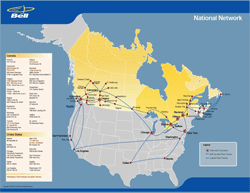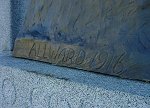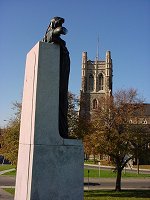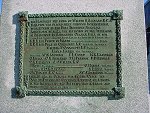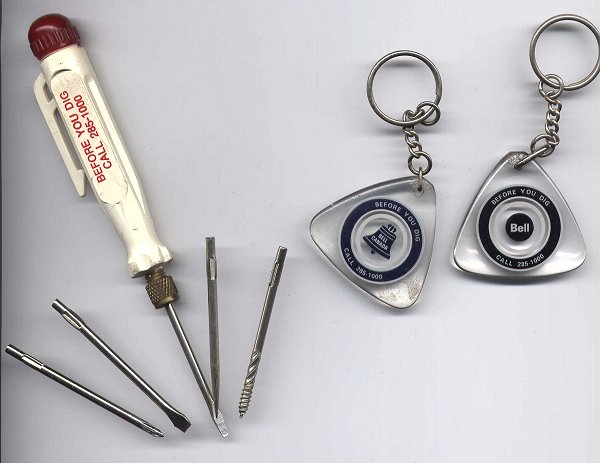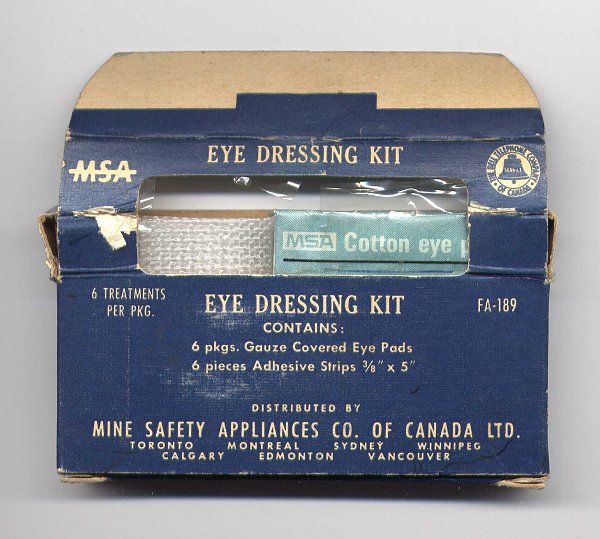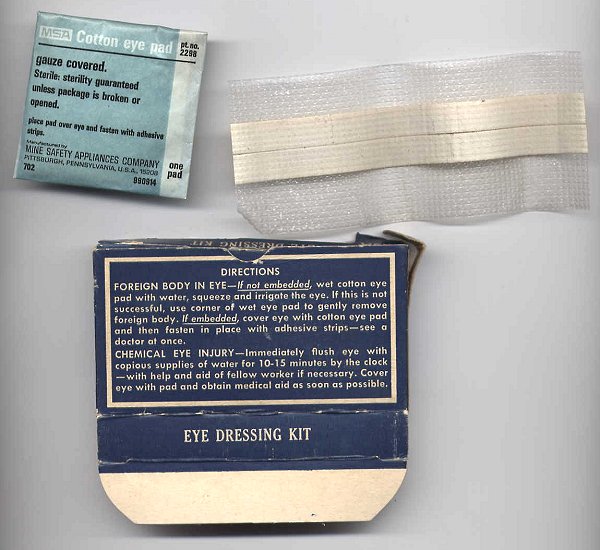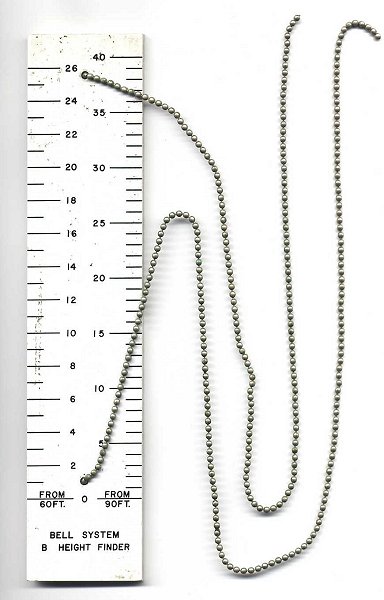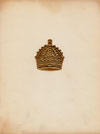
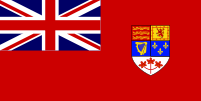

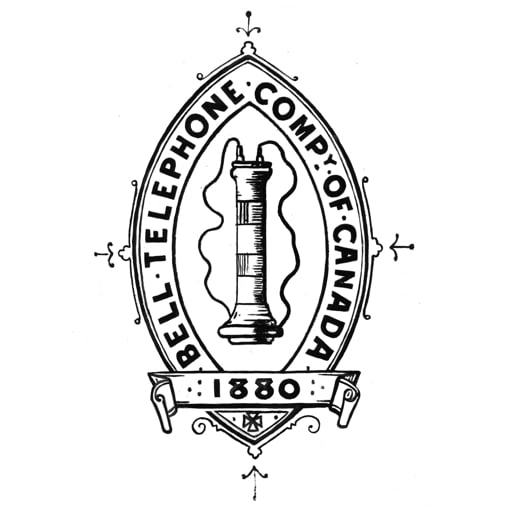
1880 - 1891 The Board of Directors adopted the first crest as Company By-law No. 14 on June 16, 1880 and it received the approval of the shareholders at a special meeting on December 13 the same year. A double red band receiver, the type used on telephone sets of the period, is depicted along with the companys name and date of incorporation.
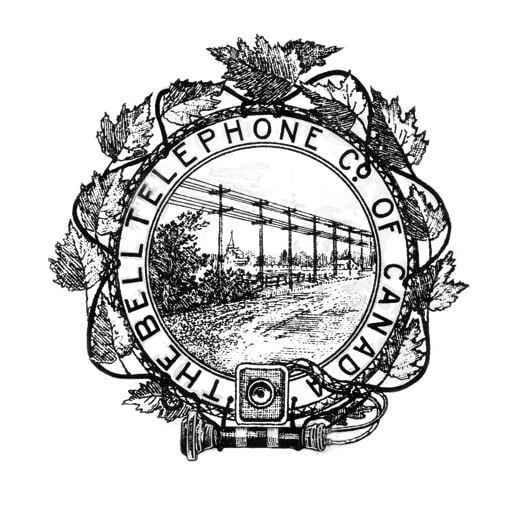
1891 - 1895 This crest has the appearance of a military badge. The Blake transmitter named after the inventor, Francis Blake and the double red bank receiver appear at the bottom of the design. A telephone pole line is illustrated in the center.
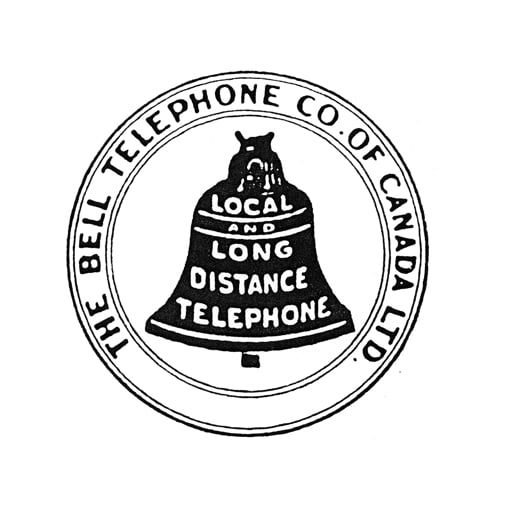
1895 - 1902 On November 29, 1895, The Bell Telephone Company of Canada obtained authorization to use American Telephone & Telegraph Companys Blue Bell insignia.
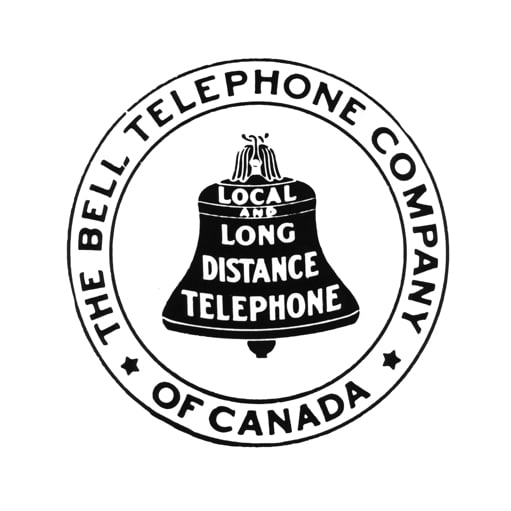
1902 - 1922 The following changes were made to the design of the logo: two stars were added and the ‘Ltd’ was omitted from the corporate name.
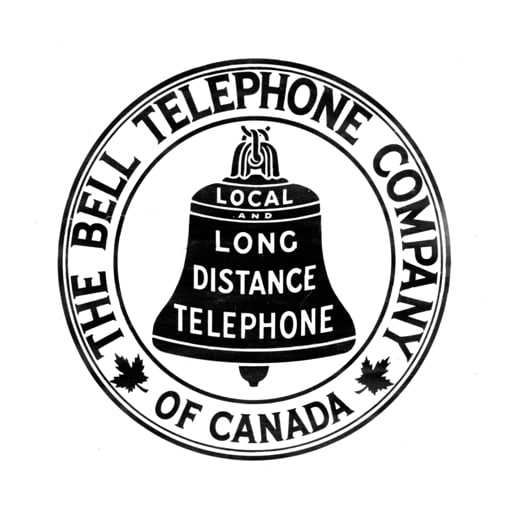
1922 - 1940 Maple leaves replaced the star, giving the logo a distinct Canadian look.

1940 - 1947 President Charles Fleetford Sise, Jr., approved this simpler design on December 18, 1939. It was introduced on January 1, 1940.
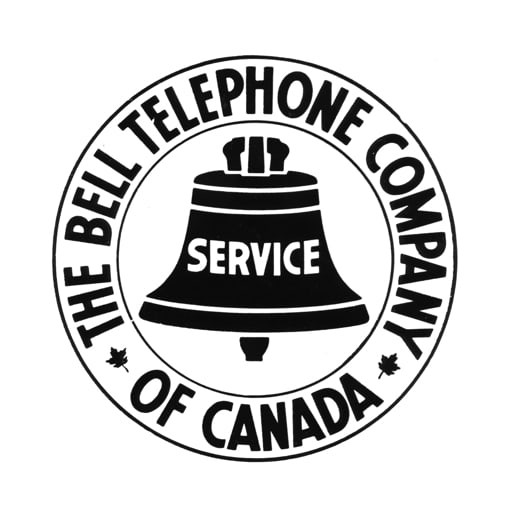
1947 - 1965 President Frederick Johnson approved this new logo in April 1947. The principal changes incorporated in the new emblem were: the substitution of the words Local and Long Distance Telephone for Service on the bell, the re-design of the bell, and an increase in the size and clarity of the company name.
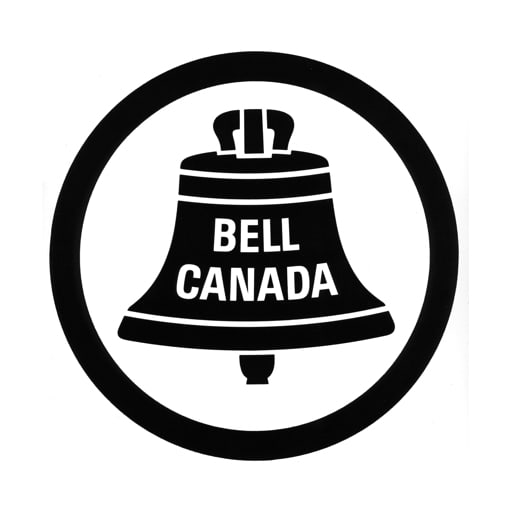
1965 - 1976 On July 30, 1965, President Marcel Vincent consented to modifications to the Company logo to reinforce the Canadian identity of ownership, management and service. The new logo displays the words Bell Canada and replaces both the English and French crests. In 1968, an Act of Parliament amended the company charter to include Bell Canada as one the legal names.
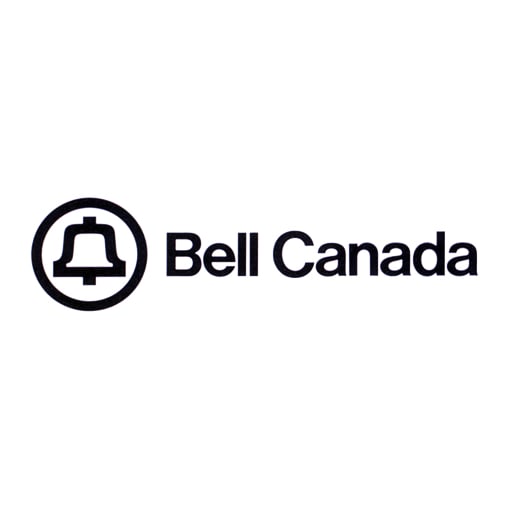
1976 - 1977 Bell art director, Colin McMichael, simplified the bell to present a more contemporary look. Coincident with the introduction of this logo, a new corporate signature, a stacked Bell Canada, made its first public appearance. The signature and logo were not used together. In fact, the signature spelled the eventual demise of the pictorial bell.
1977 - 1994 Don Black, corporate design manager, was one of the key persons involved in developing this word-symbol version of the corporate logo, making its first appearance on company vehicles in 1977. It replaced the bell symbol that, in a succession of different forms, had served as the companys official symbol since 1895 and was linked in many peoples minds with the telephone company. Bell was on its way to becoming much more.

1994 - 2008 On December 8, 1994, Bell Canada launched a distinctive new logo. At the center is the human profile, representing Bell employees and the focus of all their efforts, the customer. The profile is set within two open rings, symbolizing the dynamic future of telecommunicationsthe ability to transmit sound, image and data instantly, wirelessly, across all frontiers. The Bell name appears directly beneath the profile, a graphic representation of how the company supports customers in all their communications needs. As our primary colour for nearly two decades, the blue reflects and builds on tradition, but with a more vibrant tone. The warm yellow shade represents change.
2008 On August 8, 2008, Bell launched a new logo, tagline and advertising campaign to underline its move forward. The new Bell logo is a strong and clear representation of the company that proudly wears the traditional Blue. The brands combination of strength and simplicity supports the companys strategy of delivering a better customer experience at every level.

Bell Canada Products & Services:
Wireless, TV, Bundles, Internet and Voice
Communications for large enterprise and government
Wireless, TV, Bundles, Internet and Voice
Wireless service
Fiber optic and satellite delivered TV
Bell TV Online Satellite TV Guide
Coreless & corded phones, accessories and small business phone equipment

2008 Bell Canada National Network:
Click on map to view larger image of the Bell Canada IP Backbone Map.

Bell partners with AT&T for roaming services

Bells transitioning to an HSPA network is no secret. As such is the case, the Canadian carrier is making sure that everything is all ironed out and ready to go, including US roaming, once they roll out nationwide coverage later this year. Click HERE to read the article.
Click HERE for the official news release from BCE (Bell Canada Enterprises).

The following article is from the March/April 1975 Bell Telephone Magazine
BELL CANADA: A NEW BALANCE
Canada – once described by its prime minister as “a mouse in the shadow of an elephant” – persistently has been nurturing a unique economic, political, social and cultural national identity. Asserting that their country is not “just another state,” Canadians are searching for a new balance which precludes the United States from dominating their way of life yet retains mutually beneficial relationships between the two countries.
The same sort of search for balance has characterized decisions leading to the June 30, 1975, termination of AT&T’s service agreement with Bell Canada, and to the subsequent relationship between the two companies.
Paralleling license contract arrangements with Bell System companies in the United States, a succession of agreements has made Bell System research and communications experience available to Bell Canada since 1880. The latest service agreement, which went into effect July 1, 1949, provided for a duration of 10 or more years until terminated by either AT&T or Bell Canada on one year’s written notice. Under these terms, in October, 1973, AT&T and Bell Canada mutually agreed to end the service agreement, and shortly thereafter AT&T announced it would sell its remaining Bell Canada shares.
“This parting of our corporate ways means Bell Canada is ready to stand on its own-to serve its Canadian customers as they want to be served,” reflects AT&T Chairman John deButts. “Over the years our relationship with Bell Canada always has been most satisfactory. It’s largely a result of Bell Canada’s development of its own research and manufacturing capabilities that we mutually agreed to terminate AT&T’s ownership position at this time.”
Bell Canada’s Chairman Robert Scrivener concurs. “This action is just a final step in a long process by which our ties have been changing,” he says. “Canada has its own regulatory climate, its unique geography, its own life-styles. Through our associations with the Bell System over the years, we in Bell Canada have been helped and encouraged to develop our own skills and abilities- that is why Canada has telephone service equal to the best in the world. That is why we are ready now to serve on our own.”
Bell Canada historically has held a distinctive position in the Bell System. In addition to being the only Bell System company outside the United States, Bell Canada has experienced differences in regulatory relationships, industry structure and ownership.
The sale of AT&T’s last holdings of Bell Canada stock earlier this year, for example, culminated a 45- year decline in proportionate AT&T ownership. Although the number of Bell Canada common shares held by AT&T-nearly 750,000-had not changed since 1930, AT&Ts percentage of Bell Canada’s total equity had dwindled steadily. Beginning in 1933, U.S. residents were not able to participate in Bell Canada stock issues because its shares were not registered with the Securities and Exchange Commission; as a result, every time new shares were issued, the proportion of the total held by AT&T was reduced.
When Bell Canada was founded in 1880, the American Bell Telephone Company, forerunner of AT&T, provided 24.9 per cent of the equity capital. In the company’s first decade, AT&T made additional investments, and holdings reached a peak of 48.8 per cent in 1885. Although the proportion declined after that year, AT&T held more than one-third of Bell Canada’s equity until 1923. In 1930 AT&T’s holdings represented 25.1 per cent of the shares outstanding, but in the years following World War II, proportionate AT&T holdings diminished: When investors bought AT&T’s 749,992 shares on January 27 of this year, the shares represented only 2 per cent of the Bell Canada common shares outstanding and 1.8 per cent of total equity.
In return for paid-up Bell Canada stock, the American Bell Telephone company agreed in 1880 to transfer to Bell Canada the Canadian patent on Alexander Graham Bell’s invention and all future patent rights in Canada for telephones or other telephonic devices. References were made subsequently to exchanges of information “along engineering, manufacturing and commercial lines,” but a formal contract for services rendered by AT&T to Bell Canada was not negotiated until 1923. Under the General Service Contract of May 16 of that year, AT&T agreed, among other things, to continue “its fundamental work of research in the science of telephony; furnish engineering assistance; furnish advice and assistance in financial matters”; and “exchange data and technical advice in connection with the construction, maintenance, repair and operation of plant.” For these services Bell Canada agreed to pay a minimum amount to be increased proportionately to its gross revenues; six years later these payments were defined as a straight percentage of gross revenues.
The 1923 contract had been in effect for 26 years when it was superseded in 1949 by the agreement which will be terminated this summer. Providing generally for the same services as the earlier contract, the 1949 document specified that Bell Canada’s compensation to AT&T for services would be either one per cent of gross revenues or the percentage paid by the U.S. companies, whichever was less; it ended the 1880 and 1923 agreements and provided new arrangements concerning mutual patent rights between the two companies.
Although the 1949 service agreement provides specifically for a termination procedure, the decision to terminate has fostered considerable soul-searching on both sides of the border: ramifications of the termination go far beyond the sale of Bell Canada stock.
“It raises some fundamental questions,” declares W. Brooke Tunstall, director of corporate planning studies, who heads coordination of the transition for AT&T. “We’re dealing with our relationship not just to Bell Canada alone but also to the entire Canadian telecommunications industry and the quality of service that exists in and between the two countries. The question is not primarily how to terminate the relationship. Rather, we must determine what the Bell System posture with the Canadian telecommunications industry- including Bell Canada-should be after June 30.”
Bell Canada and its nine operating subsidiaries serve most of the eastern half of Canada, together accounting for 70 per cent of Canada’s 11.7 million telephones. General Telephone subsidiaries in British Columbia and northeastern Quebec serve another 12 per cent of Canada’s telephones; Alberta, Saskatchewan and Manitoba have provincially owned systems, and there is a municipally owned system in Edmonton, Alberta, making up another 15 per cent; scattered small independent companies serve about 3 per cent of the market. Bell Canada has service agreements with most major Canadian companies (excluding General Telephone subsidiaries), furnishing services much like those AT&T furnishes to Bell Canada.
Bell Canada’s manufacturing subsidiary, Northern Electric, serves a substantial portion of the Canadian equipment market, and Bell Northern Research, held jointly by Bell Canada and Northern Electric, is the research and development arm for both companies. Although Western Electric provided capital when Northern Electric was formed in 1914, its ownership soon settled to less than half; following the Consent Decree of 1956, Western disposed of its Northern Electric stock, and its dealings with Northern Electric today are essentially the same as its dealings with other equipment manufacturers. Northern Electric owns a number of subsidiaries, including Northern Telcom, which manufactures and sells equipment in the U.S.
Integrated structure
It is no coincidence that Bell Canada’s structure resembles the integrated Bell System pattern, according to Wilfred Anderson, who is Bell Canadas vice president-engineering and planning and Tunstall’s counterpart for the transition. “Just as Bell Laboratories and Western Electric have grown to serve the Bell System, so have we in Canada developed research and manufacturing capabilities to meet Canadian service, regulatory and financial needs. Northern Electric and Bell Northern Research likewise are vital to the high-quality, low-cost service Bell Canada offers: without this kind of structure, Bell Canada would find it difficult to achieve this level of performance.”
Two other entities play major roles in Canadian telecommunications. The Trans-Canada Telephone System (TCTs), a consortium of the major companies, including Bell Canada, serves a planning and coordinating role for inter-province and U.S.-Canada service. Similar in some respects to AT&T’s Long Lines, the TCTS differs because it does not own or operate facilities: individual members own and operate the facilities within their own territories. The second major entity is the federally owned Canadian overseas Telecommunications Corporation (COTc), which handles traffic outside of the North American network.
Concern for network
The network has been a key concern for both parties in planning for the termination and will be the basis for a continuous-although altered-relationship between TCTS member companies and the Bell System.
“The present high quality and low cost of service between the U.S. and Canada are dependent upon a smoothly functioning, integrated North American network,” asserts Anderson. “The network is planned, designed, engineered and operated as a single entity: The fact that two countries are involved is all but ignored in most instances.
Four items are essential to the maintenance of the integrated network:
A unified numbering plan so that special access codes are not required for international calls.
Alternate-route switching based on traffic volumes, for efficient use of the network.
Day-to-day management of the network, involving dealings between Long Lines, TCTs and switching centers in both the U.S. and Canada. (Two of the 12 regional network switching centers are in Canada: one in Montreal and one in Regina, Saskatchewan.)
Compatible signaling and transmission standards throughout the network.
Since announcement of the termination, Bell Canada and AT&T teams have been planning to assure that these elements are maintained. “We already have a pattern established between the Bell System and the U.S. independent telephone companies,” Tunstall points out. “The key issue is a vehicle permitting the exchange of information that is required to maintain the North American network-we need to share enough information with all the Canadian companies about our plans and technical standards to support the unified DDD numbering plan, the alternate-route switching, day-to-day network management, and unified signaling and transmission standards.”
The vehicle is the TCTS, with which precedent for a relationship already exists. Under terms of a 1971 interconnection and service agreement between AT&T and consortium members, Long Lines deals through TCTS with Canadian telephone companies, including Bell Canada, in planning and operating the North American network. After the termination, Long Lines will expand this contact role with the TCTS, since the latter organization, rather than Bell Canada, will be the point to which information will flow directly. A new Canadian relations manager at Long Lines will be responsible for day-to-day transactions with the consortium. The manager will be the principal link between the Bell System and the Canadian telephone companies, just as the Bell-Independent managers are with U.S. independent telephone companies.
Untangling other AT&T-Bell Canada relationships has been perhaps a more difficult task than resolving network concerns.
“When you take stock of a relationship that’s grown over nearly a century, you begin to realize the vast scope it now covers,” Anderson says. “AT&T has been a very useful sounding board for exchange of new ideas. This easy relationship is going to be missed by our people, particularly staff groups who are used to a good deal of contact, but that’s not to say that Bell Canada is ill-prepared for the termination.
“Planning really started after the Consent Decree in 1956, when we recognized that we would be less dependent in the future on AT&T and Western Electric. At the same time, we began to identify certain needs peculiar to Canada. For example, we had a special requirement for a very small packaged central office, and we manufactured a significant number of these. With the gradual introduction of new Canadian systems and technology, there was a need to develop supportive practices and training material. More recently, as our environment has continued to diverge from that of the Bell System, we have developed appropriate measurement plans and information systems.”
How to conclude joint projects already under way without jeopardizing either company’s contribution has been the subject of continuing negotiation.
“We have been seeking a clear resolution of all issues,” Tunstall says, “in order to bring about a fair and amicable settlement with minimum transition costs and intervals.”
Participation ceases
In general, Bell Canada no longer will participate in cost-sharing projects after June 30; however, Bell Canada participation will continue in projects which can be completed shortly after that date. Some aspects, such as data systems development, are expected to require a longer transition period to permit Bell Canada to build up its ability to take over maintenance. In other areas, the same policies and procedures will apply to Bell Canada and Northern Electric-as well as to the other Canadian firms-as apply to other foreign companies. In addition:
Centralized training will be available where there is a strong need to know (network management, for example) and on the same basis as U.S. independent companies.
Royalty-free patent rights will be granted to Bell Canada only for patents already in use; Western Electric will be responsible for all other patent licensing arrangements.
Bell Canada will retain the right to use information previously supplied for telephone operations.
The handful of employees on rotational assignments will return to their home companies by the termination date.
Bell Canada will continue to use the Bell name in Canada.
Continuing comradeship
As Canadians and Americans are hammering out these kinds of solutions to the myriad of issues the termination raises, there is personal nostalgia for the historic vital partnership that is being altered so fundamentally.
“Many telephone people in the U.S. have expressed regret that regular contacts with their Bell Canada counterparts will end,” says Tunstall. “We have learned to expect good ideas from Bell Canada people, and for them to send topflight employees for assignments at ‘195’ and as instructors in Bell System schools.”
“Bell Canada and our affiliates could not have achieved our present strength and capability without our Bell System heritage,” says Scrivener, who is 1974-75 president of the Telephone Pioneers, “but the personal friendships and associations I have gained with Bell System people transcend any legal or organizational relationships. Above all is the respect I have developed for the integrity and capability of the men and women throughout the Bell System.”
“We have shared a great history,” deButts told Scrivener last fall at the Pioneer General Assembly. “I wish you a great future, and I see no end to the comradeship that binds us as telephone people …. "
In spite of these kinds of feelings, however, there is agreement that the arm’s-length relationship sought between the two companies will suit more correctly the needs of both and tip the scales in favor of the new balance for which both have been searching. Inherent in the transition, as well, is a reaffirmation of the wisdom of an integrated structure, which Bell Canada has exploited to develop its own competence and which the Bell system will call upon (through Long Lines) to maintain the North American network after the termination.
Statistics for 1975:
(GTE ==> 12% (1.4 Million Phones)
(Government Owned ==> 17% (2 Million Phones)
(Bell Canada ==> 60% (7.1 Million Phones)
(Bell Canada Subsidiaries ==> 8% (0.9 Million Phones)
(Independents ==> 3% (0.3 Million Phones)
Changes in the Bell ** **System ties with Bell Canada up to 1975

The following information was sent by Ian Angus of Angus TeleManagement Group. (As of 1999)
Historically, Canada has had separate phone companies in each province, although Bell Canada operates in two. We never had an equivalent of AT&T which owned local phone companies. Instead, we had local (provincial) phone companies which formed a consortium to handle interprovincial calling, etc.
BC Telephone is the incumbent telco in British Columbia, the westernmost province of Canada. It has long been majority owned by GTE. BC Tel recently (this year) merged with Telus, the Alberta telephone company. The merged company is 26% owned by GTE.
Bell Canada is the current name of the Bell Telephone Company of Canada. Its operating territory is the provinces of Ontario and Quebec.
Bell Canada was part of the U.S. Bell system and minority (2%) owned by AT&T until the 1970s, when it became completely separate. This year (1999), Ameritech bought 20% of Bell Canada.
Bell Canada is majority owned by BCE Inc., a holding company which also owns Nortel and other telecom companies. Bell Canada itself owns substantial parts of several other Canadian phone companies.

The following photos were sent courtesy of former Bell Canada employee, T.J. Logie, and they depict a 60’s era Bell Canada Splicer. Thank you to T.J. Logie who not only supplied the photos, but also spent much time and dedication in restoring the Bell Canada Splicer.


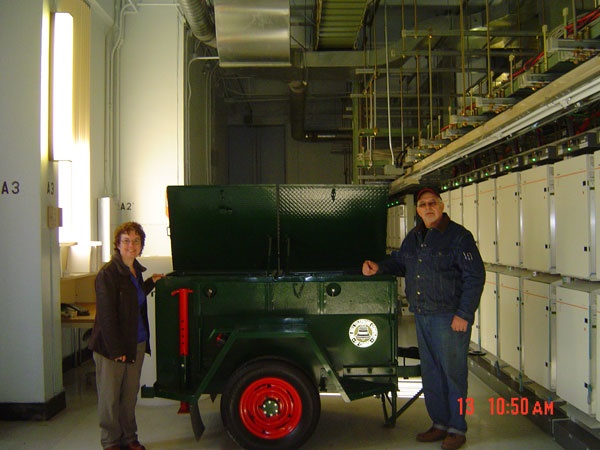


I would like to contribute a photo or two of a 1960’s era Bell Canada Splicers Tool Cart that I restored and donated to the Bell Canada Historical Collection in March 2009.
I am a Bell Canada Retiree who retired in 1990 with 33 years service mostly with the Construction Department . I worked in both the Province of Quebec and Ontario and also spent five and a half years as a Construction Manager with Bell Canada International seconded to Saudi Telephone.
I had the Splicers Tool Cart stored in a barn for nearly 18 years and decided in 2008 to restore it and Donated it to the Historical Collection.
It was completely taken apart , sandblasted , primer applied and then powder coated in the Old Bell Telephone Green with red wheels. New electrical wiring and new tires were installed along with a set of yellow powder coated Manhole Guards. It was taken from Milton Ontario to the Bell Historical Collection in Montreal.
Do hope you can use the photos.
Best Regards
T.J. Logie
Milton Ontario

A trip through Bell Canada’s history from “Step Back in Time”
Here are just a few interesting stories that you will find at the Bell Canada’s web site. Check out their site for all of the great stories they have to offer. To view each story on the Bell Canada history page, click your browser’s “refresh” button. Here are three samples:
In 1923, the Company began to honor acts of “courage and devotion,” recognizing that employees are sometimes called upon to make great sacrifices to fulfill their roles as public servants. In 1964, Addie McCormick, a 64 year-old switchboard attendant at the Beacon Arms Hotel in Ottawa, stayed at her post to warn guests when a serious fire broke out. She perished in the fire. Once a chief operator in Bell Canada, she was posthumously awarded the Royal Canadian Humane Association’s gold medal for her “heroic devotion to duty.”

The Blake magneto telephone was the first standard telephone of the Bell Telephone Company of Canada. It was made of three boxes: the top box contained the magneto generator which the caller cranked to ring central; the middle box contained the mouthpiece for the transmitter - an improved, clearer transmitter invented by Francis Blake in 1878; and the lower box contained a wet battery which supplied the necessary electrical current.
 In
1899, the first of many public coin telephones in Montreal was installed
in Nicholl’s Drug Store at the corner of Bleury and St. Catherines
Streets. Since those days, Bell Canada’s pay telephone technology has come
far. In 1987, Bell’s “universal” pay phone made its debut. It
was a set that would accept coins, calling cards and credit cards, an
improvement over the Cartophone which accepted only cards.
In
1899, the first of many public coin telephones in Montreal was installed
in Nicholl’s Drug Store at the corner of Bleury and St. Catherines
Streets. Since those days, Bell Canada’s pay telephone technology has come
far. In 1987, Bell’s “universal” pay phone made its debut. It
was a set that would accept coins, calling cards and credit cards, an
improvement over the Cartophone which accepted only cards.
Furthermore, it cost half as much to produce, since Bell was retrofitting their classic Centurion payphones rather than building entirely new units. Other improvements were numerous, such as an improved card reader, a volume control mounted on the casing rather than the handset for more efficient adjustment, and four buttons that could be individually programmed for 911, taxi service, car rental or any other potential customer needs and services that the pay phone’s location might suggest.

Canadian Reverting Information as told by
Claude Sterling - ATCA member #1437
I can remember in 1947 (I was 17 then and fascinated by anything about the telephone) visiting an uncle in Ottawa. They had a 302 with an unusual dial the only letters on it were M, J, R & W. Ottawa was using a 5 digit numbering plan and must have been a mix of dial and manual service. Toronto at that time was the 2L+4D that I was used to in the Seattle area. I have recently acquired two WE dials with only the M, J, R & W on them, this must have been common throughout the Bell System in areas where 5D provided sufficient numbers available. Prior to DDD, many Pacific Telephone dial offices were 4D and in some small CDO’s only 3D!
As to the “Busy Back” tone, some of the later manual CO’s in the Bell System were set up to reduce the time that operator had to spend on a call. The keyshelf was equipped 4 large buttons labeled M, J, R & W. The operator only had to press the appropriate button and retire from the call. If the line “tip tested” busy, she then plugged her front cord into a “Busy Back” jack and go on to the next call. In either case she had to monitor her cord lamps to see that the calling party hung up in due time. I believe that for a one party line (no party line letter) she only had to give one pull on a normal ringing key.
When a manual office reached the size that a single position could not reach all of the lines, the “B” board was introduced. In the usual configuration, the “A” board would have a row of interposition trunks. If the number she needed was on the “B” board and she would plug into a “B” trunk. When the “B” operator answered (usually with a plug ended trunk) the “A” operator would hear a “zip zip” tone and would repeat the number to the “B” operator.
In one particular CO (Walla Walla, Washington) one of the last manual offices to go down, Pacific Telephone used an unusual numbering plan for 8 party suburban service. Since this is a farming community, there was a higher percentage of suburban subscribers. The 7XXX group was reserved for suburban service and the tip parties all had even numbers and the ring parties odd number. This must have been necessary with the party line ringing buttons, the keyshelf only have one ringing key per cord pair that was used for bridged ringing. Thus, it was not possible for the operator to use coded ringing such was “W4” or “J2”, etc.
A given suburban line would look like this:
- Tip Party Ring Party
- 7404R1 7505R1
- 7504R2 7505R2
- 7504R3 7505R3
- 7504R4 7505R4
- 7504R5 7505R5
The tariff called for 8 party service, 10 codes were available in theory there would always be a vacant code so a disconnect could be left vacant for the life of the directory. In practice, in many cases, line build out fell short of growth forcast and lines were loaded to 10 parties. It was necessary to use the “X” code for new connects until the new directory was issued.
Example: If 7540R1 was disconnected and reassigned to a new subscriber he would be assigned 7504R1X on a temporary basis. There was some means of marking the lamp cap for disconnected parties and the “X” would tell the operator to ignore the disconnect, thus if you asked for 7504R1 she would tell you the number had been disconnected, if you asked for 7504R1X she would go ahead and ring the number.
There were many unhappy subscribers with codes R4 and R5 as the operator would ring so fast that it was very difficult to distinguish the break in the coded ring.
At my family home we went from 20 party Farmer Line service to 8 party suburban manual service 1459W4 to dial service in less than a year. Dial service used coded ringing as follows:
- W or J 1 became 1 long ring
- W or J2 became 2 short rings
- W or J3 became 1 long and 1 short
- W or J4 became 1 long and 2 shorts
- W or J5 became 1 long, a short and a long.
There seemed to be no correlation between your number and any other party on the line. Looking back on it now, certain levels or hundreds must have been set up for certain ring codes. To call another party on your line you simply dialed the number received a busy tone and hung up. If you were a tip party calling another tip party you would hear the appropriate ring, if you were calling a ring party, you would hear a series of long rings with a very short interval between. When the ringing stopped you would pick up the handset and say “hello”.

The British Columbia Telephone Company, Limited
The following information was extracted from BC TEL’s
history web pageprior to it becoming Telus.
The new history page is now:
http://about.telus.com/careers/history.html#bctel
(thank you Sheila de Peuter for letting me know about the URL change)
Telephones were first installed in B.C. in 1878 at two locations on Vancouver Island. William Wall, a mechanic at Dunsmuir, Diggle and Company’s Wellington Colliery, manufactured two telephones and connected them to a line between the mine and the loading docks at Departure Bay, a few miles away. At about the same time, Robert McMicking, superintendent of British Columbia Telegraphs, leased two telephones from the Bell Telephone Company of Canada and installed them on a line between his home and an office in Victoria.
Telephones on the mainland soon followed. A missionary working in a remote Indian fishing village near Prince Rupert hung a line between the village store and the sawmill. And a contractor working on the new Canadian Pacific Railway strung wire through the Fraser Canyon so he could talk with his supervisors.
From these modest beginnings, a new industry emerged. In 1880, the Victoria and Esquimalt Telephone company was established - B.C.’s first. By the turn of the century, there were as many as 45 small phone companies in B.C.
Perhaps the most ambitious was the Vernon and Nelson Telephone Company. With its incorporation on April 20, 1891, 15 years after the telephone was invented, a group of telephone visionaries began the realization of a dream - to build a province-wide telephone service. BC TEL traces its corporate history directly to that dream.
In 1904, after buying up a number of the smaller telephone companies throughout the province, the Vernon and Nelson Telephone Company changed its name to The British Columbia Telephone Company, Limited. The name – British Columbia Telephone Company – was established in 1923 under a federal charter the company had obtained in 1916. This marked the start of BC TEL, which remained relatively unchanged until May 1, 1993, when BC TEL reorganized under a holding company, BC TELECOM Inc.
Concurrent with the creation of the holding company, the telephone operating company changed its legal name from British Columbia Telephone Company to the more familiar BC TEL.

Here is a contribution from Emily Purchase, Administrative Assistant to the Mayor’s Office of the City of Brantford (a.k.a. “The Telephone City”), Ontario, Canada. She sent a scan of the Bell Telephone Memorial and Bell Homestead souvenir booklet which you can view by clicking HERE(PDF format). You can find out more by visiting the web site. The home page for the City of Brantford is HERE.
Emily also sent some photos from the memorial and you can view the full-size images by clicking on the thumb-nail images below:
SKETCH-MODEL No.8
Read about the monumental sculptor, Walter S. Allward, that created the Alexander Graham Bell monument by clicking HERE. Here is his description of his creation:
Description to Accompany Sketch Model of Proposed Bell Telephone Memorial
n making this model I have tried to cover as much space as possible, owing to the large area of the proposed site, and to create a design which would be interesting and expressive in outline from any point of view. The design has been purposely made as wide as possible so as to express the idea of great space between the two allegorical figures representing the speaker and the listener.
I have treated the subject in a simple, broad way in order that it might be expressive and easily understood by the average observer.
To the left of the large panel it is intended that there shall be a large portrait in relief of Bell, modeled from life. The head is only suggested in the model as I did not have a satisfactory photograph.
The dominant notes I have tried to express are:
First, man discovering his power to transmit sound through space. This is shown in the large sculptured panel, the three figures representing three messengers, Knowledge. Joy and Sorrow.
Secondly, the two Heroic figures at either side represent Humanity, sending and receiving messages. On the back of the design are four pilasters and at the top of each might be placed emblems of the most important nations in the world. Between these run the line of telephone and binding the whole is the line of the earth’s curvature, expressing the world-wide use of the telephone. The figure of “man” could be draped should there be any objection to the nude. Inscriptions would be placed on the monument according to the wishes of your committee.
MATERIAL AND COST
Granite Work -The pedestal to be built of granite cut and erected in the best possible manner, free from all defects in material, workmanship or construction.
Sculpture- The two figures of “Humanity” at the extremes of the design (left and right) also the relief of “Bell”, and that of his invention to be cast in standard bronze.
The large panel in relief containing five figures to be carved in fine granite.
The whole to cost twenty-five thousand dollars ($25,000.00).

To view two different Canadian postal mail envelopes honoring A.G. Bell and the telephone, click on the two links below:

Here is the CRTC listing of Independent Telephone companies acquired by Bell in Canada since 1960 (including date of acquisition). It is an MS Word document and you must have an MS Word plug-in for your browser to view it. This link discovered by Dave Hunter.
http://www.icce.ca/eic/site/smt-gst.nsf/eng/sf06084.html
If the above link is dead, an archive of the document is mirrored on my server and can be viewed/downloaded by clicking HERE.

Pierre in Canada sent the following pictures of some items he has from his days with Bell (Canada). The last picture is a height finder. He states, “I never could figure how it works but it was used by design plant engineer to get the height of a pole.” Click on the images below to see full-size:

Click on “The Bell Homestead logo above to visit that web site.
Thanks to Emily Purchase (Administrative Assistant, Mayor’s Office, City of Brantford “The Telephone City”) for this link!

We Offer Personalized One-On-One Service!
Call Us Today at (651) 787-DIAL (3425)



Click on the link below to view information on Bell Canada’s
former research and development unit.
Northern Electric - A Brief History

These be your Kings
Published by Northern Electric 1937
The following book was sent courtesy of Robert McKinnon of British Columbia. This book was published by Northern Electric in 1937, and details the history of the English and British Monarchs from 1066 to 1937. This is a great historical resource, and is a welcome addition to the Bell Canada historical site. Thank you Robert for your contribution.
Click above to go to site.



Reliable, secure high-speed internet
With CenturyLink Simply Unlimited Internet, you can choose from a wide range of available speeds that fit your online needs. Plus, you can connect several devices with super-fast in-home WiFi.
Order Now




